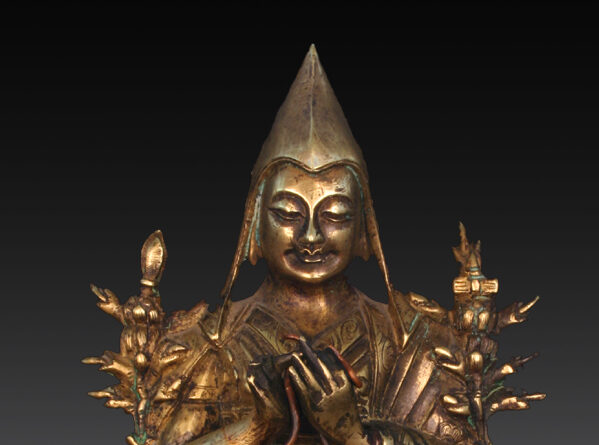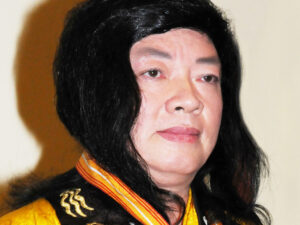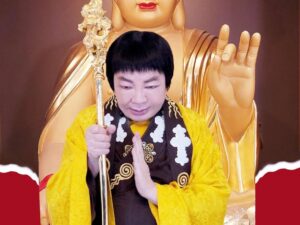C41(A)-Three Principal Stages & Paths of Buddhist Practice
- Description
- Curriculum
- Reviews

This course is not the complete Lam Rim Chen Mo that is listed as course C40. That epic work will hopefully be added to the curriculum some day and will probably use as its main text one of the reference books this course will also use: Master Pabongka Rinpoche’s Liberation in the Palm of Your Hand, which is based on a famous series of discourses given in Tibet in 1921 on Je Tsongkapa’s Lam Rim Chen Mo. That book is used in this course to offer supplemental readings for those who want more details. To go even deeper, you may also refer to the three volumes of Je Tsongkapa’s classic Lam Rim Chen Mo (The Great Treatise on the Stages of the Path to Enlightenment) that Pabongka used as his text as that book is said to contain the essence of all of Shakyamuni’s open teachings. We are told that Tsongkapa became a Buddha while in the bardo.
This course uses two very short lam rims (only fourteen verses each) by Tsongkapa that also include Pabongka’s commentary. These lam rims offer more concise descriptions of Tsongkapa’s approach to training his thousands of disciples about the stages of the path to enlightenment and how to prepare to be successful in the tantric practices that can enable you to become enlightened in your current lifetime. The Three Principal Paths found in Pabongka’s The Principal Teachings of Buddhism focuses more on developing the path of gaining the correct view of emptiness, but also the other paths of renunciation and bodhichitta as does the beautiful Source of All My Good, which is contained in Pabongka’s Preparing for Tantra: The Mountain of Blessings, a prayer for blessings and offering of gratitude for these three stages of progression on the path to Buddhahood.
The course will also provide links to key teachings by H.H. Dorje Chang Buddha III as they relate to progression through these stages and paths of Buddhist Practice. It is appropriate to study the works of these two great Buddhas together as there are many similarities. Both were Holy Beings who, as promised by Shakyamuni Buddha, incarnated in this world during times of great disruption and turmoil and in the midst of corruption within the institutions of Buddhism. Both were reformers intent on offering the teachings in a pure and correct way to help living beings become holy beings themselves and both presented the dharma in a way that was appropriate for their time and place.
Both lam rims used in this course have three paths plus certain preliminaries, but Preparing for Tantra adds an Initial Stage that offers the provisional goal of high status & favorable rebirth, which is not a Buddhist goal per se, but is an initial stage shared with those of lesser capacity and for many who are just beginning on a spiritual path. This first step taken to stop non-meritorious behavior requires gaining an understanding of impermanence and the laws of cause and effect. It can lead to taking refuge that can lead to the next stage that has the goal of escaping samsara for nirvana as an Arahat. This is then labeled the Intermediate stage shared with those of medium capacity and represented by the Path of Renunciation with the goal of individual liberation. The next stage with the goal of developing bodhichitta and the liberation of all beings and eventual Buddhahood is the Great Stage of the Mahayana path that shares two branches: the cultivation or method Path of Bodhichitta and the contemplative or Wisdom Path of gaining the Right View of Emptiness. The different schools or methods of practice offer a traditional path with open steps for those of greater capacity and the quick or secret steps for those who are also of greater capacity, but more impatient and eager to reach the highest levels of practice. The actual secret or Vajrayana practices are not included in this work per se, but it is understood that it would be foolish to enter those kinds of practices without the grounding in all the previous stages of learning and practice.
It is obvious that Je Tsongkapa taught many forms of the lam rim, depending on the situation and needs of his students. Because the essential concepts of impermanence, karma, and reincarnation are not part of the core philosophical principles of western society, we will include the initial stage to give more focus on those concepts. Hopefully this model will help provide context and a way of seeing how each teaching leads to a higher teaching and that they all lead to our ultimate goal of complete liberation from samsara and eventual Buddhahood.
This course is intended to give you an understanding of Tsongkapa’s vision and methods as well as his practice of the Dharma that existed in ancient India and Tibet. It is also to give us a way of seeing how our own Buddha Master, H.H. Dorje Chang Buddha III, used His teachings to lead us on this same path and where He introduces new Dharmas for our time and age and corrects some of the corruption that has manifested in this Dharma Ending Age.
The curriculum will include assignments, quizzes, and supplemental materials, and allows for group discussions and debates. Most of this course is available for those enrolled in the free membership program for AUDITING STUDENTS. However, the parts that include the Expounding the Absolute Truth through the Heart Sutra are only available for those who are part of the paid membership program as are the homework and recordings of other classes for DCB12, DCB35, and P10. The actual texts of the latter courses–The Dharma of Cultivation, Learning from Buddha, and The Great Dharma of Zen Practice by H.H. Dorje Chang Buddha III are all available for downloading by anyone as they have all been published in print or available on the internet. Both the Supreme and Unsurpassable Mahamudra of Liberation or Expounding the Absolute Truth through the Heart Sutra will also be available to the public when they are published in print or on the internet in English. Auditing Students are not required to do any of the homework assignments.
Click on the “CURRICULUM” tab to review this course. If you have not registered for a membership, please click on “Membership” on the top menu bar to select your membership and enroll in this course. If you wish to take the course for credit and be able to access the other courses referenced in this course you are also required to complete the application form provided in course “G02-Spiritual Autobiography” prior to being admitted to either the BUDDHIST STUDIES or the XIUXING SEMINARY PROGRAMS. CLICK for detailed Procedural Guide under the “STUDENT MANUAL” in the website’s top menu bar for more information.
Prior to viewing this course, you are required to listen to the caveats provided in “PRELIMINARY STEPS” of Section 1 of the curriculum, which is a requirement for all preliminary translations of the Buddha Master’s teachings. You must first be familiar with who H.H. Dorje Chang Buddha III is and His accomplishments while on this earth by reviewing the material covered in G01(A)-H.H. Dorje Chang Buddha III, A Treasury of True Buddha-Dharma and watching “Discovering the Root of Buddhism, Propagating the True Buddha Dharma.” You will also need to be familiar with many of the Buddha Master’s teachings including: D01(A)-Supreme and Magnificent Dharma, D35(A)-The 128 Evil and Erroneous Views, D03(A)-Impermanence, D02(A)-On Suffering, D13(A)-Cutting Off Attachment to Self, and D56(A)-Benefiting Living Beings. There may be others as more English translations become available and courses are developed. You should also read or listen to The Great Dharma of Zen Meditation (P10), Learning from Buddha (DCB35), and The Dharma of Cultivation (DCB12). The texts for these courses may be downloaded directly from the curriculum of those courses by anyone.
Buddhist Studies and Xiuxing Seminary Students should also read or listen to The Supreme and Unsurpassable Mahamudra of Liberation (P01 & P02X) and Expounding the Absolute Truth through the Heart Sutra. Although the Expounding the Absolute Truth through the Heart Sutra is not yet available except as a preliminary translation at the Holy Vajrasana Temple, you are encouraged to listen to the group discussions included in DCB21-DCB26 as they become available. This is the most comprehensive and important Dharma transmitted to us by His Holiness. It offers the complete wisdom part of our training and is the path to gain a right view of emptiness that surpasses even Tsongkapa’s vision as included in the Lam Rim.
On the method side, the Buddha Master’s Supreme and Unsurpassable Mahamudra of Liberation is the definitive work of developing the path of bodhichitta along with His Dharma of Cultivation (DCB12) also listed above. The more allegorical Sutra on Understanding and Realizing Definitive Truth (DCB33) and The Monk Sutra (DCB10) should also be heard or read whenever they are available for their teachings on emptiness and the nature of reality.
This course is listed as suitable for beginners even though it introduces many advanced concepts. It is intended as a survey course to show the entire scope of Buddhist teachings, but not in the detail of the corresponding advanced courses.
-
3C41-LESSON ONE: Background-Forwards & introductions to HHDCBIII, Je Tsongkapa, and Others
This lesson introduces you to your Buddha teachers-H.H. Dorje Chang Buddha III & Je Tsongkapa & provides the roadmap for the course.
-
4C41-Watch the video “Discovering the Root of Buddhism, Propagating the True Buddha Dharma”
-
5C41-Watch the video “How Buddhism Came to the West (Simplified version)” to set the context for the unfolding of the teachings.
-
6C41-Assignment 1-Introduction (Questions 1-13)
-
7C41-Watch video of April 29, 2023 Discussion of Lesson 1 (Questions 1-13)
-
8C41-LESSON TWO: The Preliminaries to Taking the Path
-
9C41-Listening to and Propagating the Dharma
-
10C41-Watch video of D01(A)-Supreme & Magnificent Dharma
-
11C41-What Is Cultivation?-Part I
-
12C41-Read Article on Five Vidyas to better understand H.H. Dorje Chang Buddha III
-
13C41-Other linkages to related Dharma Discourses by H.H. Dorje Chang Buddha III
-
14C41-Take a Lama (Spiritual Guide or Friend) & 128 Views
-
15C41-Start or increase your meditation practice to build your skills at concentration.
-
16C41-Assignment 2-The Preliminaries: (Questions 14-38)
-
17C41-Watch video of May 6, 2023 Discussion of Lesson 2 (Questions 14-38)
-
18C41-LESSON THREE: The Initial Stage
-
19C41-Watch the Video on D03(A)-Impermanence
-
20C41-Watch the Video on D02(A)-Suffering
-
21C41-Four Laws of Karma
-
22C41-Read & Practice "Ten Wholesome Behaviors"
-
23C41-Read & Practice "The Wrongs of Others Are My Wrongs"
-
24C41-Read Sutra & Watch the Videos on DCB26-How to Realize Prajna for Discussion on the "Ten Wholesome Behaviors." (Not available for Auditing Students)
-
25C41-Read & Practice the "Purification-the Four Opponent Powers"
-
26C41-Taking Refuge
-
27C41-Assignment 3: The Initial Stage: (Questions 39-62)
-
28C41-Watch Video of May 13, 2023 Discussion of Lesson 3A (Questions 39-59)
-
29C41-Watch Video of May 20, 2023 Discussion of Lesson 3B (Questions 60-62)
-
30C41-LESSON FOUR: The Intermediate Stage-Path of Renunciation
-
31C41-Watch Video on D12(A)-Cutting Off the Twenty Dharmas
-
32C41-Read Sutra & Watch the Videos on DCB23 & DCB24-Expounding the Absolute Truth through the Heart Sutra as they are available
-
33C41-Assignment 4: The Intermediate Stage-12 Links of Conditioned Origination (Questions 63-154)
-
34C41-Watch Video of May 27 Discussion of Lesson 4A (Questions 63-83)
-
35C41-Watch video of June 10 Discussion of Lesson 4B (Questions 84-89)
-
36C41-Watch video of June 17 Discussion of Lesson 4C (Questions 90-109)
-
37C41-Watch Video of June 24 Discussion of Lesson 4D (Questions 110-141)
-
38C41-Watch Video of July 15 Discussion of Lesson 4E (Questions 142-154)
-
39C41-LESSON FIVE: The Great Stage-Method Path of Bodhichitta
-
40C41-What Is Cultivation?-Part II
-
41C41-Seven-point Mind Training
-
42C41-Read the Cultivation Chapter from “DCB35-Learning from Buddha”
-
43C41-Assignment 5A-5C: The Great Stage-Method (Questions 155-202)
-
44C41-Watch video of September 23, 2023 of Lesson 5A (Questions 155-172)
-
45C41-Watch Video of October 28, 2023 of Lesson 5B (Questions 173-188)
-
46C41-Watch video of November 4, 2023 of Lesson 5C (Questions 189-198)
-
47C41-The Supreme and Unsurpassable Mahamudra of Liberation: Lessons 5D-5I
-
48C41-Assignment 5D-5I: The Great Stage,"Supreme and Unsurpassable Mahamudra of Liberation" (Questions 203-282)
These questions are to be for your use in assessing your understanding of this Dharma. You do not need to submit your answers to LFBCS, but click the completed button when you are satisfied that you can answer all of them.
The PDF "How to Purify Negative Karma with Vajrasattva in the Context of the Four Opponent Powers" is provided as optional background reading to supplement the discussion of the SAUMOL Vajrasattva Practice.
-
49C41-Watch the Video on P01-Introduction to the Supreme & Unsurpassable Mahamudra of Liberation
-
50C41-Watch the Video on P02X-Practice of the Supreme & Unsurpassable Mahamudra of Liberation
-
51C41-Watch Video of November 18, 2023 of Lesson 5D (Questions 199-202; 203-222)
-
52C41-Watch Video of December 2, 2023 of Lesson 5E (Questions 223-235)
-
53C41-Watch Video of December 9, 2023 of Lesson 5F (Questions 236-257)
-
54C41-Watch Video of December 16, 2023 of Lesson 5G (Questions 258-266)
-
55C41-Watch Video of December 30, 2023 of Lesson 5H (Questions 267-276)
-
56C41-Watch Video of January 6, 2024 of Lesson 5I (Questions 277-297)
-
57C41-Study and practice the Six Paramitas
-
58C41-Assignment 5J-5K Paramitas (Questions 283-314)
-
59C41-Watch Video of January 13, 2024 of Lesson 5J (Questions 298-312)
-
60C41-Bodhisattva Vows
-
61C41-Assignment 5.2: The Great Stage, Other Bodhichitta Generating Dharmas (Questions 315-316)
-
62C41-Watch Video of January 20, 2024 of Lesson 5K (Questions 313-316)
-
63C41-LESSON SIX: The Great Stage-Wisdom Path of Right or Correct View of Emptiness
-
64C41-Watch the Video on P01-Introduction to the Supreme & Unsurpassable Mahamudra of Liberation
-
65C41-Watch the Video on P02X-Practice of the Supreme & Unsurpassable Mahamudra of Liberation
-
66C41-Read Sutra & Watch the Videos on DCB21-Imparting the Absolute Truth through the Heart Sutra -Part I.
-
67C41-Assignment 6: The Great Stage-Prajna and Dhyana (Ta) Questions 317-369
-
68C41-Watch Video of January 13, 2024 of Lesson 6 (Questions Ta-Part 1)
-
69C41-Watch Video of January 20, 2024 of Lesson 6A (Questions 317-354)
-
70C41-Watch Video of February 3, 2024 of Lesson 6B (Questions 355-369)
-
71C41-Read Sutra & Watch the Videos on DCB22-25-Imparting the Absolute Truth thro
-
72C41-LESSON SEVEN: The Conclusion
-
73C41-Read “Learning from Buddha” on tantric practice and implementing both cultivation and tantra Dharma.
-
74C41-Practice the Supreme & Unsurpassable Mahamudra of Liberation
-
75C41-Realize prajna from Imparting the Absolute Truth through the Heart Sutra
-
76C41 - Conclusion (Questions to be added)




